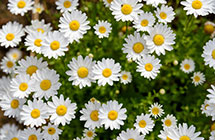10种鲜花的英文名及含义,兰花的竟然这么污,不忍直视
|
大家都知道雏菊的英文名是daisy,但你知道它的含义吗?Daisy来自于古英语短语dægesege,表示“日之眼”。因为雏菊黎明花开,黄昏花谢,好像生长于天地之间的眼睛一样。不过,兰花的英文名就没有这么好听了,不仅不优雅,甚至名字还有点污。
1. CARNATION [kɑr'neʃən] There are two etymologies for carnation, a term found in English in the early 1500s. According to one, carnation may be a corruption of coronation, perhaps because the flower’s toothed petals resembled crowns or because the flowers were worn, crown-like, as garlands. The second etymology comes from the flower’s original color, and roots carnation in the Middle French carnation, “pink complexion,” from the Latin root caro, “flesh,” source of less delicate words like carnal and carnage. 2. CHRYSANTHEMUM [krɪ'sænθəməm] The word chrysanthemum, emerging in English in the late 1500s, comes from the Greek krysanthemon, meaning “gold flower.” The first component, krysos (“gold”), shows up in the biological term chrysalis. The second, anthos (“flower”), appears in anthology, literally “a collection of flowers,” first used for a compilation of small poems in the early 1600s. 3. DAISY The word daisy has deep roots in the English language. As attested to in some of English’s earliest records, daisy comes from the Old English phrase dægesege: the “day’s eye,” as the flower’s white petals close at dusk and open at dawn, like the eye of the day as it sleeps and wakes. 4. ANEMONE [ə'nɛməni] The anemone is also known as the windflower. Indeed, the word anemone, first attested in English in the mid-1500s, probably comes from a Greek word literally meaning “daughter of the wind.” It's said that the brightly colored petals of this flower only opened when the wind blew. Sea anemones took their names in the late 1700s on their likeness to the flowers. 5. FORGET-ME-NOT The name forget-me-not was a direct translation from the Old French ne m’oubliez mye (“do not forget me”). Renaissance romantics believed that, if they wore these soft-colored flowers, they would never be forgotten by their lovers, making the flower a symbol of fidelity and everlasting love. 6. ORCHID ['ɔrkɪd] Orchids are a diverse family of extremely elegant flowers, but the literal meaning of their name, documented in English in the early 1840s, is a bit earthier, shall we say. Orchid comes from the Greek orkhis, meaning “testicle.” The flower's bulbous roots, often paired, have long been thought to resemble those male organs. 7. PEONY The peony, a word found in Old English, was believed to have healing properties in early medicine, which is why its name might honor Paion, the physician of the gods in Greek mythology. 8. RHODODENDRON [,rodə'dɛndrən] Like many other flower names, rhododendron enters the English record in the mid-1500s. The name literally means “rose tree” in Greek. It’s an apt name, for this shrub or small tree blooms with brilliant, rose-colored flowers. 9. TULIP Passing into English via Dutch or German in the late 1500s, tulip actually comes from the Turkishtülbent, based on the Persian dulband:“turban.” The flower, to its ancient namers, resembled the male headwear worn throughout the Middle East, India, and parts of Africa. 10. VIOLET Before we had the color violet, recorded by the late 1300s, we had the flower violet, emerging some decades earlier in the same century. Violet grows out of the French violete or violette, a diminutive of viole, in turn the Latin viola, its name for this distinctively purple flower. This viola has no etymological relationship to the instrument. Some scholars suspect Latin got viola from the Greek name for the plant, ion. |









